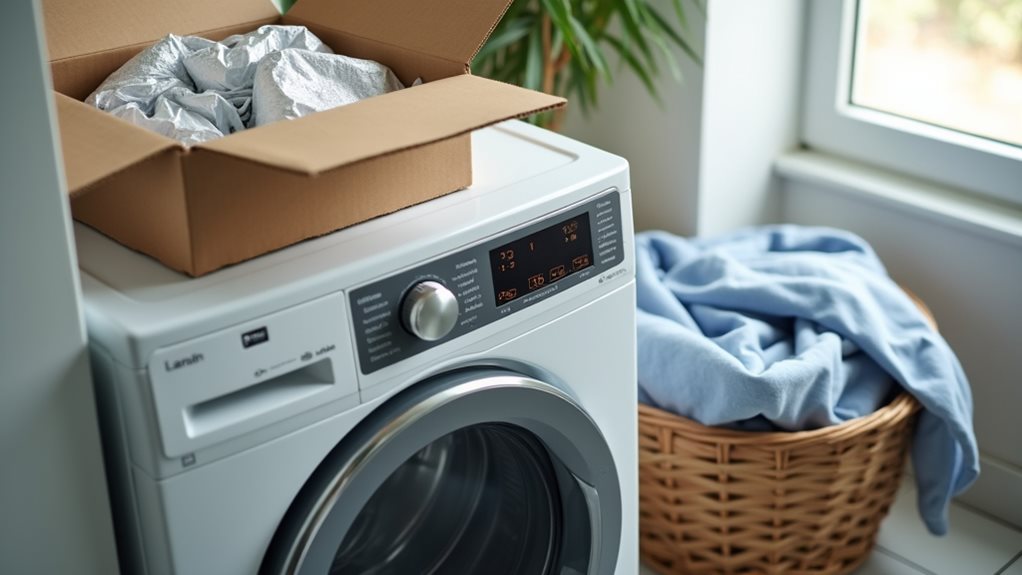Most dry cleaning takes 1-2 days for your everyday shirts and pants, though I’ve learned the hard way that delicate items like formal suits need 3-4 days, and my wedding dress took nearly two weeks 😅. Holiday rushes can stretch these times considerably, while heavily soiled garments require extra treatments that add days to your wait. Home kits work in 30 minutes but sacrifice quality, and understanding these factors helps you plan better for your clothing care needs.
The Dry Cleaning Process and Its Impact on Turnaround Time
When you drop off your favorite blazer at the dry cleaner, you’re essentially handing it over to a careful, methodical process that’s remained surprisingly unchanged for decades.
Despite technological advances in nearly every industry, dry cleaning still relies on the same time-tested methods perfected generations ago.
Honestly, understanding these steps helped me finally stop pestering my cleaner about when my clothes would be ready 😅. The dry cleaning process involves five distinct stages that directly impact turnaround time: drop-off, inspection, cleaning, pressing, and quality control.
Standard clothing items like shirts typically move through easily within 1-2 days, but special garments requiring delicate fabrics handling can extend cleaning time considerably. Wedding dress cleaning, for instance, demands extra attention during inspection and pressing phases.
Factors affecting this timeline include fabric complexity, soil levels, and seasonal volume fluctuations that stretch even routine schedules. Many establishments offer same-day service for an additional fee if items are dropped off early in the morning, providing flexibility for customers with urgent needs.
Typical Timeframes for Different Types of Garments

Three distinct categories of garments create a predictable hierarchy of dry cleaning timelines, and I’ve learned through years of wardrobe mishaps that knowing these timeframes can save you from showing up to important events looking like you raided someone else’s closet 😅.
Standard clothing items like dress shirts typically turnaround time within 1-2 days, making them your reliable go-to pieces when professional dry cleaning is needed.
Delicate garments require 3-4 days since the cleaning process must carefully address intricate fabrics without damage. Formal suits fall into this category too, needing proper attention to remove stains and dirt effectively.
Wedding dress cleaning can stretch from days to weeks depending on embellishment complexity, while larger items like comforters often take up to a week as dry cleaning takes longer for bulkier pieces.
Many dry cleaners offer expedited same-day or next-day service for an additional fee, which can be particularly useful when you need garments ready for urgent situations like business trips or special events.
Factors That Can Extend Your Dry Cleaning Wait Time

While most dry cleaning follows predictable timelines, certain situations can throw your carefully planned schedule completely off track, much like when I confidently promised my daughter her prom dress would be ready only to discover the cleaner was swamped with graduation gowns.
Holiday rushes create perfect storms of overwhelmed staff and endless queues, especially around Christmas and wedding season when everyone suddenly remembers their formal wear needs attention.
Additionally, heavily soiled garments that require extra treatments, or unexpected equipment breakdowns at your local shop, can transform a simple two-day turnaround into a week-long wait that tests even the most patient customer’s resolve.
Specialty items like wedding dresses or leather goods naturally require extended processing times of 3-5 days due to their delicate nature and need for extra care.
Holiday Rush Delays
Although most dry cleaners promise those standard one-to-two-day turnaround times, the holiday season throws a curveball that can leave you scrambling for that perfect outfit you needed yesterday.
During busy periods, increased demand transforms your reliable neighborhood dry cleaner into a bustling hub where processing time stretches like taffy 🍭.
I’ve learned this lesson the hard way, watching my go-to blazer sit in garment pickup limbo while staff limitations create bottlenecks that would make rush hour traffic jealous.
The holiday season brings everything together in a perfect storm: more soiled clothes from parties, overwhelmed workers, and delays that can extend your wait by several days.
If you need items cleaned urgently, many establishments offer same-day service for an additional fee, though availability may be limited during peak times.
Plan ahead, because holiday rush waits for no one.
Heavily Soiled Garments
Beyond the seasonal rush that can derail your dry cleaning timeline, there’s another factor that’ll make your favorite garment disappear into processing purgatory for what feels like an eternity: heavily soiled items that look like they’ve survived a food fight 🥪.
When you drop off that wine-stained blazer or grease-splattered dress, you’re fundamentally handing over a puzzle that requires additional pre-treatment, multiple cleaning cycles, and sometimes specialized stain removal techniques that can add days to your wait.
Those stubborn stains demand meticulous handling, potentially extending processing time up to a week, especially during seasonal factors like holidays when extended wait times become the norm and heavily soiled garments get pushed behind simpler jobs, creating longer wait times that’ll test your patience.
While standard dry cleaning typically takes 2-3 business days for regular items, heavily stained garments often require the extended 5-7 day timeframe reserved for specialty cleaning processes.
Equipment Malfunctions
When the heart of your dry cleaner’s operation—those industrial cleaning machines—decides to throw a mechanical tantrum, your garment fundamentally becomes a hostage in a waiting game that nobody wins 🔧.
Equipment malfunctions can seriously derail the dry cleaning process, turning what should’ve been a quick Tuesday pickup into a Friday frustration fest. When machines need repairs or maintenance, your turnaround time stretches from hours to potentially days, especially if backup equipment is already overwhelmed or nonexistent.
I’ve watched entire garments in the queue get shuffled around like musical chairs while processing times balloon beyond customer expectations.
Smart dry cleaners invest in regular maintenance schedules and communicate openly about pickup times, but mechanical breakdowns remain the ultimate wild card in this industry. Additionally, equipment issues can lead to improper ventilation, which means stronger chemical odors may linger on your garments longer than usual, requiring extra airing time before they’re ready for pickup.
Home Dry Cleaning: Time Estimates and Expectations

You’ve probably seen those home dry cleaning kits at the store and wondered if they’re worth the convenience, and honestly, they can be a decent quick fix when you’re in a pinch.
The entire DIY process takes about 30 minutes to an hour from start to finish, which beats waiting days for professional service, but here’s the thing—you’re trading speed for quality.
While these kits work great for light revitalizing and minor odors, I learned the hard way that my favorite silk blouse needed more than a tumble in a cleaning bag could deliver 😅.
For garments with intricate beading or heavily soiled items, professional dry cleaning with chemical solvents remains the gold standard for preserving fabric integrity.
DIY Kit Process
Transforming your living room into a makeshift dry cleaning station might sound intimidating, but honestly, it’s simpler than assembling IKEA furniture (and way less likely to end in tears 😅).
The DIY dry cleaning process starts with pre-treatment, where you’ll dab visible stains before tossing garments into the special cleaning bag with the provided solution.
Next comes tumble drying for 30-60 minutes, which activates everything and does the heavy lifting.
After that, you’ll let your clothes rest briefly while cleaning agents dissipate.
Before starting any home cleaning method, always test the process on an inconspicuous area first to ensure your garment won’t be damaged.
While home dry cleaning kits won’t match professional effectiveness, especially for delicate fabrics or stubborn stains, they’re perfect for freshening up blazers between wears, and the overall time investment beats waiting days for traditional dry cleaning.
Time Vs Effectiveness
Although home dry cleaning wins the speed race by a landslide, delivering results in under an hour compared to professional services that hold your clothes hostage for days, you’re fundamentally trading thoroughness for convenience, and honestly, sometimes that’s exactly what you need.
Your delicate garments and stubborn stains might suffer without specialized equipment, but when you need a decent turnaround time for lightly soiled items, home dry cleaning becomes your reliable backup plan.
The effectiveness really depends on garment material – my cotton blazer emerged surprisingly fresh, while my silk blouse looked defeated 😅.
Professional dry cleaning’s superior cleaning process takes longer because they’re actually doing the heavy lifting, but home kits offer that instant gratification when time trumps perfection.
Additionally, allowing your professionally cleaned garments to air out before wearing can help reduce exposure to traditional solvents that may still be present on freshly cleaned clothes.
Items That Cannot Be Dry Cleaned

While dry cleaning works wonders for most garments, certain items can’t handle the process and will come back looking worse than when you dropped them off.
Fur garments are particularly vulnerable because dry cleaners use chemical solvents that strip away natural oils crucial for keeping fur soft and supple.
Leather items and suede sensitive materials require specialized cleaning methods that standard facilities simply can’t provide. I learned this the hard way with a beloved suede jacket that came back stiff as cardboard! 😅
Delicate fabrics like silk and lace often shrink or lose shape, while garments with heavy beading or embellishments risk damage from the agitation process, making these treasured pieces unsuitable for conventional dry cleaning.
Items with plastic components, sequins, or certain adhesives may also melt or deteriorate when exposed to perchloroethylene and other harsh cleaning chemicals used in the dry cleaning process.
How to Properly Store Your Dry-Cleaned Garments

Once your freshly dry-cleaned garments arrive home, the way you store them can make the difference between preserving their pristine condition and watching them deteriorate in your closet.
First, ditch those plastic covers immediately—they’re moisture traps that’ll turn your beautiful blazer into a mildew magnet. Instead, invest in breathable garment bags that protect against dust while allowing air circulation.
Plastic covers are moisture traps that create mildew—breathable garment bags offer protection while allowing essential air circulation.
I learned this lesson the hard way when my favorite silk dress developed mysterious spots after plastic storage 😅.
Before hanging anything, verify garments are completely clean and free of stains, since residual marks become permanent over time.
For long-term storage, use acid-free tissue paper to maintain shape and prevent fading by keeping everything in cool, dry spaces away from sunlight.
Tips for Faster Dry Cleaning Service

When you’re racing against time and need your garments cleaned faster than usual, several strategic moves can transform your dry cleaning experience from a waiting game into a swift, efficient process.
I’ve learned that dropping off items early morning helps you avoid peak foot traffic while securing better dry cleaning time slots.
Ask your local dry cleaners about same-day service options – many offer this for basic pieces, though you’ll pay extra for timely service.
Pre-treat visible stains at home before dropping off, which reduces processing time considerably.
Choose simple garments over embellished pieces for quick turnaround times of 1-2 days.
Building relationships with staff works wonders; when you communicate urgent timelines honestly, they’ll often prioritize your cleaning turnaround based on loyalty.




